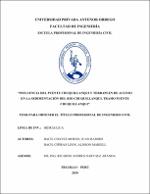Influencia del puente chuquillanqui y terraplen de acceso en la sedimentación del rio chuquillanqui, tramo puente chuquillanqui

Ver/
Descargar
(application/pdf: 20.49Mb)
(application/pdf: 20.49Mb)
Fecha
2019Autor(es)
Chavez Morán, Juan Ramiro
Cipiran Leon, Alisson Mariell
Metadatos
Mostrar el registro completo del ítemResumen
Esta investigación tiene como principal objetivo determinar la influencia del puente
Chuquillanqui y terraplén de acceso del río Chuquillanqui, tramo puente Chuquillanqui, para
ello se generaron diversos escenarios, para diferentes períodos de retorno en flujos no
permanentes, los modelos que se generaron son con puente, que recrea la situación tal cual
como se encuentra en la actualidad, el modelo sin puente, simula el comportamiento cuando
retiramos el puente y terraplén de acceso, y el modelo propuesta, es nuestra propuesta de
solución que consiste en retirar puente, terraplén de acceso y parte de topografía en los
extremos, además se plantea la construcción de un puente largo de luz de 298.00 m, apoyado
en 5 pilares y 2 estribos, la forma de los pilares se ha considerado elipsoide, pues según la
literatura y las investigaciones son los que tienen un mejor comportamiento hidrodinámico.
Se realizaron estudios de ingeniería, tales como el levantamiento topográfico en donde
se encontró que el tramo aguas arriba del puente y terraplén de acceso entre las progresivas
0+000 – 0+805 tiene una pendiente de 2.035 %, y la pendiente en el tramo aguas abajo del
puente y terraplén de acceso entre las progresivas 0+805 – 1+500 es 0.830 %. El material de
fondo es una grava gruesa, tiene diámetro característico D
50 de 27.21 mm y su gravedad específica es 2.59. Los escenarios generados han sido considerando como períodos de retorno 5, 10, 25,50 y 100 años, tomando en consideración 5 instantes por hidrograma.
Para los cálculos de la tensión de fondo y crítica se han usado los métodos de Meyer
Peter Müller y Shields, en donde la tensión crítica, es decir la fuerza necesaria para la
iniciación del movimiento es de 20.01 N/m 2, y el tirante necesario para iniciar el movimiento
en el primer tramo es de 0.12 m, y en el segundo tramo es de 0.30 m.
Como conclusión se obtuvo que el puente y terraplén de acceso si tienen una influencia
significativa en la sedimentación del río Chuquillanqui, pues estos elementos han ido
modificando la pendiente considerablemente aguas arriba como aguas abajo, con la propuesta
se estima que el río recupere su pendiente de una manera natural con el transcurrir del tiempo. The main objective of this research is to determine the influence of the Chuquillanqui
bridge and the Chuquillanqui river access embankment in the Chuquillanqui bridge section,
we generated different scenarios, for different periods of return in non-permanent flows, the
models that were generated with the bridge recreates the situation as it is currently, the model
without bridge, simulates the behavior when we remove the bridge and access embankment,
and the proposed model, is our proposed solution that consists of removing bridge, access
embankment and part of the topography. In addition, we propose the construction of a long
bridge with a light of 298.00 m, supported by 5 pillars and 2 abutments, the shape of the
pillars has been considered ellipsoid, because according to literature and research, those are
that have a better hydrodynamic behavior.
Engineering studies were carried out, such as the topographic survey where it was
found that the section upstream of the bridge and access embankment between the 0 + 000 -
0 + 805 progressives has a slope of 2.035%, and the slope in the waters section below the
bridge and access embankment between the progressive 0 + 805 - 1 + 500 is 0.830%. The
background material is a coarse gravel, has characteristic diameter D
50 of 27.21 mm and its specific gravity is 2.59. The generated scenarios have been considered as periods of return 5, 10, 25, 50 and 100 years, taking 5 instants per hydrogram to analyze.
Meyer Peter Müller and Shields methods have been used for the calculations of the
background and critical stress, where the critical tension, the force necessary for the initiation
of the movement is 20.01 N / m2, and the necessary tension for start the movement in the
first section is 0.12 m, and in the second section is 0.30 m.
In conclusion, it was obtained that the bridge and access embankment do have a
significant influence on the sedimentation of the Chuquillanqui River, since these elements
have been modifying the slope considerably upstream as downstream, with the proposal it is
estimated that the river will recover its natural slope with the passing of time.
Palabras clave
Colecciones
- Ingeniería Civil [1260]

